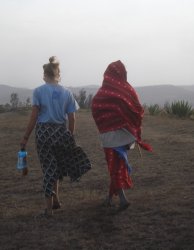Defining Gap Years in America
The American Gap Association is a non-profit recently founded by Ethan Knight in Portland, Oregon. He has lofty goals for the association, which include more clearly defining what a Gap Year is and pushing for gap year funding through established government college financial aid programs.
Knight answered our questions about Gap Years in this exclusive interview.
Tell me a little bit about yourself.
I grew up in Portland, Oregon, certainly one of the more progressively minded cities in the country. Portland was a fantastic place to grow up, but one that also had the feeling of a smaller town.
Trekking, studying and apprenticing in Kathmandu, then Tibet, then India, the year proved to be transformative in ways that, perhaps cliche, I had never imagined. Travel at that point in my life was largely about finding happiness and defining my own measures of ‘success,’ leading me to the phrase:
“mankind’s greatest limitation is that we can only dream as big as we’ve seen.”
I returned home to college and found myself quickly engrossed in those morsels my professors would share: those very same details that before I would handily write down as a note for some exam, now found me following particular morsels into the library for greater exploration.
Coming home, I availed myself of a study abroad opportunity (as 70% of Gap Year students do) through SIT in Tanzania. Eventually, I graduated from the same university I’d taken a leave of absence from, with a degree in English, philosophy, and a minor in environmental sciences.
After graduation, I moved down to California to work for Leapnow for what ended up being 7 years: from intern, to field leadership, to director of operations, to assistant director. As my tenure at Leapnow came to a close, through the strong mentorship of Sam Bull, the Executive Director there, I was able to take stewardship of their semester programs and start Carpe Diem Education here in Portland, Oregon.
Six years later, having grown each year, it became clear that the industry of Gap Years was ready for some unification thus spurning me to leave Carpe Diem and start the American Gap Association.
What motivated you to launch the American Gap Association? What’s your mission for the new association, and how do you plan to gain traction?
While there’s been a steady increase in the number of Gap Year programs out there, “Gap Years” still remained an undefined and often confusing term. It was being used for all things from taking a year off and working at your local DQ, to embarking on a sojourn of epic growth.
Some organizations have taken a lot of leadership in terms of growing their own programs, but again, without some sort of centralization the over all benefits began to be parsed out in less and less relevant ways. For instance, taking a year to work at DQ doesn’t necessarily confer the same growth trajectory and self-awareness that a focused internship in a potential future career can â?¦ unless of course you want to manage a fast food restaurant.
Carpe Diem was at a point in its office, too, that the right staff was available and ready to take over leadership and thus made the decision to branch out even more tempting.
The general mission is to unify Gap Years, drawing them under a similar banner. But the goals of the organization involves several larger points. Obviously, the chief amongst them is to increase the participation in Gap Years, but historically the limitation here has often been a financial one. Thus, my goal is to make Gap Year programs eligible for one of the six years of FAFSA eligibility absent the requisite college credit.
Gap Years are fundamentally about exposing students to a different form of pedagogy and one that when done with structure have fantastic and proven benefits. Thus, another element of AGA’s direction involves further augmenting the available data about Gap Years. Whereas in the UK the government so values these experiences, in the US, the data is relatively small, but consummately being collected by a few avid academics.
AGA is collaboratively launching our survey in the Fall of ’13 that will be the first longitudinal study of Gap Year participation in the country.
When I think of students taking a Gap Year, my mind goes to Europe. Can you explain what a Gap Year is? Maybe give an example or two of cool gap year experiences you had or have heard about?
While a Gap Year can take place in Europe, what I’ll say is that they can literally happen anywhere in the world. The idea is to use the time conscienciously, usually in exploration of a potential career, in service to those in need, in exploration of one’s own goals for college and life, and as recently written in a notable New York Times editorial, to break up the “cradle-to-college-to-cubicle-to-cemetery” cycle.
Additionally, in order to allow the time for these explorations, a Gap Year can last anywhere from 2 months – 2 years; obviously “year” is more generally used to connote an academic year and students will most commonly work for some portion of that year to contribute financially.
There are a few consistent themes I get to respond to about Gap Years. One is whether or not it’s a Gap Year if you just go get a job for the whole year. While this might be packaged as career exploration, in most cases students don’t have the skills required to work in a career-centered job – usually it’s retail and those can often become a trap.
A Gap Year almost always fits within the college plan, which is why the best advice remains for students to apply to colleges, get accepted, then ask for a deferral to do their Gap Year.
Another common theme I get to respond to is that a Gap Year is for kids who aren’t ready for college, sort of like summer school. The truth is that students take a Gap Year having deferred from Harvard as well as from community colleges. 
Additionally, students who have completed a structured Gap Year usually earn 1-2 points better in GPA, and are more likely to graduate on time.
The last big theme I get to respond to is a fear about money, that somehow a Gap Year has to cost lots of money. While there are certainly programs out there that cost on par with a private university, there are also plenty of low-cost options, some that will even provide a stipend. Additionally there are Gap Year programs that offer scholarships, financial aid, and a few even offer FAFSA funding (federal financial aid).
My own personal experience with a Gap Year frankly echoes that of most every other Gap Year out there: one of self-awareness.
But how I chose to get there was only one amongst many options. A Gap Year could mean working at a ranch in Patagonia, Argentina. Students could study a language intensively while living with homestays and volunteering in their off hours.
Students have been an au pair in France, worked with disadvantaged youth in London, learned how to sail by being a deckhand on tall ship, or done a focused internship with a variety of fields.
Honestly, the hardest part is limiting down the options because there are so many that are available. In fact, there are educational counselors out there specifically dedicated to working with Gap Year students specifically because the options are so vast.
What are some of the particular challenges Americans face when it comes to spending a Gap Year abroad? (compared to say, residents of the UK)
If anything, Americans actually have an incredibly easy time of their Gap Year. The visa situations are in some cases tricky, but getting a work visa in the EU or Australia is, for instance, fantastically easier as a young person than it is as an adult. It typically involves creating a relationship with an overseas business or non-profit, and asking them to support you, but as these rules change frequently – especially since the recession – it’s best to check the State Department’s website and then visit the visa requirements of any country you want to travel to.
If you’re ever going to go overseas on your Gap Year, it’s HIGHLY recommended that you register with STEP, the Smart Traveler Enrollment Program as a part of the State Department.
As an American, there are some general things to concern yourself with in areas that might harbor some negative sentiments about Americans. In those cases, it’s best to check the State Department for any travel warnings, make sure you have adequate medical and political evacuation insurance policies (through iNext, International SOS, or HTH as the big ones), then perhaps even go so far as to get a Canadian flag and stitch it onto your backpack 🙂
Americans are almost never explicitly targeted except in those obviously anti-American countries. In fact, I was recently in Pakistan and even there felt a strong appreciation for American people, albeit a frustration with the American government … this sentiment is quite common even in those areas commonly considered anti-American. It may seem funny, but it wasn’t more than a few years ago that I used to claim Canadian citizenship in conversations as a way to allay any prejudices people might have. These days I’m much more comfortable saying that I’m an American.
Languages are the other consideration. People who have grown up in the EU tend to have a fluency in several languages which is an obvious aid when traveling. Americans are rarely fluent in multiple languages and thus learning a new language to the point of fluency is often listed as one of the main reasons to take an international Gap Year.
Otherwise, I’d say, when traveling as an American, the best thing to do is to avoid finding yourself trapped with other Americans. It’s partially human nature to connect with those environs that are most familiar to us, but clearly, being in a foreign culture and uniformly surrounding yourself with other Americans is an exercise in missed opportunities. So, make sure to extend yourself and connect with the local peoples, wherever that may be, just be conscious about what local norms are, especially if you’re a single woman as the considerations for single women traveling are more numerous than for men.
Where might some of the easier places for an American to go on a Gap Year? I’m thinking for work permits or student visa acquisitions…that sort of thing.
There’s no shortage of good places for Americans to go thankfully. Work visas are getting harder to acquire due to the recession and global unemployment numbers, but they’re still available. Typically, the EU, or Australia are those areas most commonly considered easier to get that all too coveted work visa. But it takes time and certainly isn’t a last minute affair to get the proper visas.
That being said, finances are one of the biggest issues in going on a Gap Year and there are certainly parts of the world where the US dollar goes much farther than other places.
In the UK, for instance, the pound is much more valuable than the dollar thus costing Americans more to stay there. In Uganda, however, there are about 2,600 Ugandan shillings to the dollar. Granted, you can’t buy anything for a shilling, but the cost of living is that much cheaper in the developing world or where currencies are in the favor of the USD.
Airfare is another consideration, and one that a lot of people limit by traveling exclusively within our hemisphere – the US, Central America, and parts of South America can be quite reasonable (even cheap) to fly to, but you’ll have to check your flights and typically book them early or on a student fare.
All of that being said, if you’re looking for a phenomenal experience – you can get that just about anywhere. If you’re looking for a cheaper option, then Central America is a fantastic place to go with an abundance of need for good and dedicated volunteers plus the ability to focus on a language study.
But truth be told, the Gap Year is most often about exploring your own personal passions: I’m a big fan of the saying that “Passion is a better predictor of success than IQ will ever be,” but that’s the problem with our current school system is that we don’t have classes on finding your passion.
So, really, each student’s particular passion should be their driving focus in developing a structured Gap Year. Perhaps the hardest part is finding what you’re curious about and then taking the courage to launch out into the unknown.
For more information, check out the Resources section of our website.
I guess you don’t necessarily have to take a Gap Year abroad, right?
That’s exactly correct, many students find excellent placements in the States, and lord knows you can always find a cross-cultural experience within the States – whether traveling from Colorado to a Hurricane Katrina affected area, or going from a city to working in the wilderness.
There are programs in the States exclusively, such as City Year (an AmeriCorps programs) or, even an internship program based exclusively in Worcester, MA. called Dynamy. There are outdoor environmental conservation organizations that are always looking for volunteers too.
The options are really plentiful, but the cost can often be a bit more if you’re unable to work out a room and board situation.
Your website hints at a role that universities/colleges play in facilitating gap years. Can you explain this a little bit?
This is one of my favorite questions… Gap Year students end up back in a four-year institution at an order of 90% within one year. Universities such as Harvard, Princeton, Yale, Brown, … all of them are overwhelmingly in support of a Gap Year. And, let’s be honest, there’s no doubt that a college degree is in the best interest of the majority of the population – who said more education was ever a bad thing?
Gap Year graduates do better in university by 1-2 points in GPA, are shown to be more engaged in campus activities, and generally graduate earlier than their peers. All of the reasons are compelling within a college trajectory.
In fact, one of the most common reasons listed, (as Karl Haigler and Rae Nelson’s research has shown) is general burnout from academia. Many students take a Gap Year as a way of recharging their academic batteries, and, in my mind the most important aspect, is that students finally have an opportunity to establish a real world connection between the theories they may have read about in books and the people that are actually doing the work.
We’re exposed to so many subjects in school – obviously some more immediately relevant than others – but without taking the time to see how those subjects meet reality, that knowledge gets lost to the reams of tests and forgotten as we pass grade to grade.
Now, the order of operations in college admission is important: typically, Gap Year students should apply, get accepted, then ask for a deferral from their chosen university. It’s not uncommon, however, that some students will change their university preference based on the experiences they have on the Gap Year – typically as a reflection of a refinement in their focus for careers. Whereas, for instance, they may have been thinking marine biology at first, after some time interning with an actual marine biologist, they may have decided that their interest is more about marine preservation than the actual science. Thus, potentially changing to more of a public administration / political sciences focus.
Some students even use their Gap Years to fuel secondary applications for more prestigious universities. When most of us are applying for college we’re writing essays based on some pretty limited life-experience and those Gap Year graduates who apply to other colleges inevitably have much more to say in their admissions essays.
And you will be accrediting organizationsâ?¦are those organizations that put together gap year experiences/programs? Give some examples.
The AGA will be accrediting Gap Year organizations – not individual programs. In short, there are simply too many programs out there that are options for a Gap Year. This means, perhaps an internship agency in the States, or a group program, or even there are sailing programs that work with students teaching them about sailing and the environment as part of their program.
The AGA Standards are broken into 6 different certifications that an organization can seek depending on what programming their individual organization offers.
- Philosophy and Ethics – every organization seeking accreditation will need this certification.
- Backcountry / Developing country (for those organizations taking students 2 hours away from definitive 1st-world medical care)
- Partnerships (for homestays, or outsourcing outdoors activities, or …)
- Individual Placements (for internships where students are more independent)
- Volunteering (doing volunteer work responsibly requires much greater consideration and is critical to not being more of a burden than a help to that community)
- Environmental Sustainability (for organizations that choose to establish a strong commitment to the environment)
We’ve received an incredible amount of positive feedback about what we’re doing with AGA, even lots of UK Gap Year organizations have reached out looking for information and support. Some of those organizations that we’ll be accrediting include:
- Thinking Beyond Borders
- Carpe Diem Education
- Global Citizen Year
- CIEE’s Gap Year programs
- Sea | Mester
- Dynamy Internship Year, and
- hopefully some of the more outdoors organizations like Outward Bound and NOLS.
I saw on your website some information about a Scholarship and Financial Aid for gap years. What are those things all about?
Scholarships and financial aid are two of the biggest places where people run aground in their Gap Year planning. So, when we developed the plan for AGA, we knew that greater access to financial aid was a top order of importance.
Right now I’m scheduled to be in meetings with my senator’s office to discuss how we can best make FAFSA funds available for Gap Year students.
FAFSA, or the Free Application for Federal Student Aid, is one of the hallmarks of college financial aid, and also opens the door to numerous scholarships and grants.
While I’m well aware this will be a several-year process, I’m also acutely aware that students who want this experience need more access to traditional funds, and knocking on your church pastor’s door to fundraise can only go so far.
If students are interested in going with any particular program, I would say that as an industry, Gap Year organizations are less interested in making money and more interested in having a real and positive impact on their students.
That being said, there are also low-cost options that are out there, including WWOOF, SERVAS, and many other non-profit resources.
The challenge is then finding the reputable ones and doing your due-diligence to make sure that you’ll be safe. I encourage you to use the AGA standards as a template to think through your own vetting process if you plan on going in a more independent direction: www.americangap.org/standards.php. As the saying goes, you don’t know what you don’t know, … so use our Standards to help fill in the blanks!
AGA does indeed have a separate 501.c.3 foundation that we’re just beginning fundraising for, and that will work in concert with our grassroots national initiative to reach into Parent Teacher Associations and other school boards.
The plan with this new national initiative will be to have these community partners reach out to high school students with the “Back-a-Gapper” program. The students will apply for scholarships to their PTA, then the PTA will select two winners per school, and through their own fundraising be able to supplement students with a set scholarship amount. AGA, using our own 501.c.3 will then add to that students’ pool depending on our current resources.
This is an ambitious project and one that will likely take at least a year to foment, but one that I think is the best avenue towards more inclusion in Gap Year participation excepting only FAFSA availability.
The bottom line is that Gap Years don’t have to be expensive, and there are many programs that actually are able to offer current financial in substantial numbers, like UNC’s Global Gap Year Fellowship program, or Princeton’s Bridge Year Program, or even Leapnow, Carpe Diem Education, Global Citizen Year … all of which can also offer college credit.
KEEPING TABS ON ETHAN KNIGHT:
Organization: American Gap Association
Website: www.americangap.org/
Facebook Page: www.facebook.com/americangapassociation
Twitter Handle: @americangap or twitter.com/americangap


 Teach English in Asia
Teach English in Asia  Cruise Ship Jobs
Cruise Ship Jobs  Alaska Fishing Industry Jobs
Alaska Fishing Industry Jobs  Sharing Economy / Gig Economy
Sharing Economy / Gig Economy